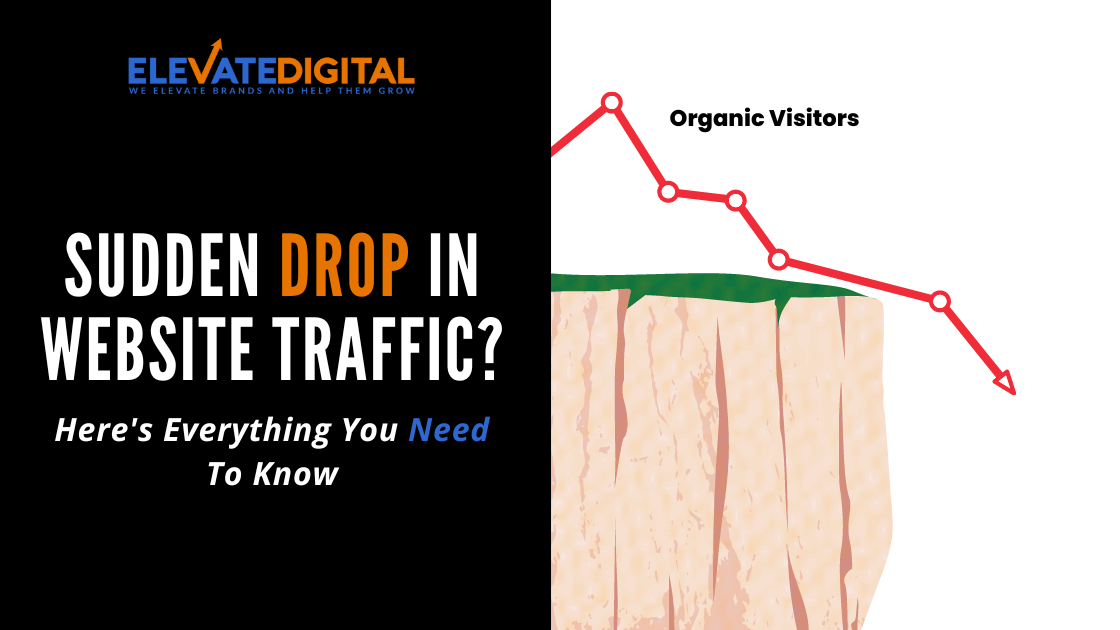A drop in website traffic can be problematic for any business owner. After all, a website is only successful if people are actually visiting it. If you’ve noticed a recent dip in traffic, don’t panic! There are a few possible explanations, and it’s usually not as bad as it seems. In this blog post, we’ll discuss the methods of diagnosing a drop in website traffic, some of the most common causes of a drop, and what you can do to fix it.
But before we get into the crux of the topic, we’ll need to understand the different types of website traffic and what a drop in website traffic means for businesses.
Types of web traffic
Organic – traffic that arrives at your website from a search engine. This is the most important type of traffic for most businesses since it indicates that people are actively looking for your product or service. The traffic could come from people searching for your brand directly or landing on your informational content that ranks for various search queries.
Referral – arrives at your website from another site. For example, if you have a blog post that gets linked to from another site, that will send referral traffic your way. This can be a valuable source of traffic, but it can also be volatile since it’s not under your direct control. Review and listing sites are good sources of referral traffic.
Direct – traffic that ends up on your website by typing in the URL directly, or from a bookmark. Here’s where you should be aware of this fact – marketing attribution is never 100% right. So, if you were to look up your Google Analytics, you might see a good percentage of your total traffic being attributed to direct though it might not be true. If you’re a new brand experiencing this, you can be clear that there’s a spillover of traffic from other mediums into this channel. But if you’re a well-known brand, all your direct traffic(as per Google Analytics data) might actually be direct.
Paid – this is the traffic that arrives at your website from a paid advertisement, such as a Google or Facebook Ad.
Email – traffic that comes to your website from email campaigns. Email traffic can be highly valuable since it’s usually from people who have already shown an interest in your product, service, or content.
Social media – people visiting your website from social media sites. Social media traffic can be valuable, but it can also be volatile since it’s often reliant on algorithms that are out of your control.
What does a drop in website traffic mean for businesses?
- Decrease in leads and sales
- Reduced online visibility
- A decrease in website authority
- An increase in customer acquisition and marketing costs
The above reasons are precisely why a drop in traffic is a business-critical problem
Auditing the drop in traffic
Google Analytics – The first step is to identify the time period during which you experienced the drop in traffic. Once you’ve done that, log into your Google Analytics account and pull up a report for that time period. Check to see if there was a drop in overall traffic or just certain types of traffic, such as organic or paid.
You can also segment the traffic by source to see if the drop was across the board or just from certain channels.
If you notice a drop in traffic from a particular channel, that’s a good place to start your investigation.
If the drop had come from organic traffic, time to dig into your Google Search Console (GSC) and other rank-tracking tools.
Google Search Console – Check your GSC account to look for a sudden drop in organic traffic. This is a good way to identify if there was a problem with your website’s ranking or if you lost any organic search traffic. If you see a drop in organic traffic, check to see if there were any manual actions taken against your site or if there were any sudden changes in your website’s sitemap or robots.txt file. You can also use third-party tools like Semrush or Ahrefs for the same.
If the drop had come from paid traffic, start auditing your ad campaigns
Check your Ad accounts – If you’re running any paid advertising campaigns, such as Google or Facebook, or Twitter Ads, check to see if there were any changes made that could have caused the drop in traffic. For example, if you paused your campaign or changed your bid strategy, that could explain the decline.
Website logs – Reviewing your website’s logs can also help identify the cause of a drop in traffic. Your web server logs will show you all the website visits, including any bots or crawlers. If you see a sudden drop in website traffic from a particular source, that could be the cause of the problem.
Check for website downtime – One possibility is that your website was down for some time and that’s why you experienced a drop in traffic. You can use a service like Pingdom to check for website downtime.
Once you’ve reviewed all the data, you should have a good idea of whether there was an actual traffic drop and the primary reason for the same.
12 possible reasons for a traffic drop
You changed your domain name/URL
If you’ve recently changed your domain name or URL, that could explain the drop in traffic. It can take a little while for search engines to re-index your site under the new URL, so your traffic will likely dip for a week or two until everything is back to normal. In the meantime, make sure to update your URLs on all of your marketing materials (including business cards, flyers, etc.) and social media accounts. This will help ensure that potential customers are still able to find your site.
Google algorithm update
Another possible explanation for a drop in traffic is that Google has rolled out a new algorithm update. These updates happen multiple times per year, and they can sometimes cause fluctuations in traffic. The best thing to do in this situation is to wait it out and see if your traffic returns to normal within a week or two. In the meantime, make sure your website is following all of Google’s best practices so that you’re in good standing when the next update rolls around.
You stopped blogging/ posting regularly
If you used to blog or post regularly on social media but have since stopped, that could be why your traffic has decreased. Consistent blogging and social media posting help keep your site visible and relevant, so if you’ve fallen off the wagon lately, now’s the time to get back on! Schedule some time each week to sit down and write a blog post or create some social media content. These are critical in improving the traffic to a new website. It may seem like a lot of work at first, but trust us – it’s worth it!
Stale content
If you haven’t updated your website in a while, the content might be starting to feel a bit stale. If people visit your site and see the same thing they saw the last few times they were there, they’re not likely to come back. Make sure to freshen up your content regularly – whether that means adding new blog posts, updating your product descriptions, or anything in between. A little bit of effort can go a long way in keeping people engaged with your site.
Major drops in the rankings of sites linking to you
If the referral traffic is what’s causing the overall traffic drop, here’s your problem – sites linking to you have dropped in rankings and hence the effect. There’s nothing you can do about this. Look to compensate for this by improving your efforts on SEO and launching new paid campaigns
Poor site design
If your website is hard to navigate or isn’t visually appealing, that could be why people are leaving without taking any action. If you’re not sure whether your site design is up to par, it might be worth hiring a professional web designer to take a look and give you some feedback. Making even a few small changes can make a big difference in how people interact with your site.
Competitors doing better
If you’re in a competitive industry, it’s possible that your competitors are simply doing a better job than you when it comes to marketing and SEO. If you think this might be the case, take a look at their websites and see what they’re doing that you’re not. It could be anything from creating more content to choosing the right keywords for it. Once you identify what they’re doing, you can make some changes to your own website so that you can better compete with them.
Website not mobile-friendly
In today’s world, it’s more important than ever to have a mobile-friendly website. With so many people using their smartphones and tablets to browse the web, if your site isn’t optimized for mobile devices, you’re likely losing out on a lot of traffic. Make sure your website is responsive and easy to use on all devices. If it’s not, now is the time to make some changes!
Slow loading times
If your website takes forever to load, people are going to click away before they even have a chance to see what you have to offer. Make sure your site is optimized for speed so that people can see what you have to offer without waiting around. There are a few ways to do this, including reducing the size of your images and using a content delivery network.
Your website copy isn’t engaging enough
If your website copy isn’t engaging, people are going to lose interest and click away. Make sure your copy is interesting and easy to read so that people stick around long enough to learn more about what you have to offer. You can also use strong calls to action to encourage people to take the next step, whether that’s signing up for your email list or making a purchase.
There’s a problem with your web hosting
If your website is down or running slowly, that’s a surefire way to lose traffic. Make sure you’re happy with your web hosting provider and that your site is always up and running smoothly. If you’re having problems, reach out to your provider for help so that you can get things back on track.
Traffic loss to specific pages
If you’re noticing a drop in website visits to specific pages on your website, the reason could be anything from outdated content to a broken link. Take a look at the pages in question and make changes to see if you can get the traffic up – updating content, and running a page-specific link-building campaign.
New VS returning users
If you’re noticing a drop in traffic from new users, it could be an issue with how your site is being found online. Make sure you’re doing everything you can to optimize your site for SEO and that your marketing efforts are reaching the right people. If the drop is coming from returning users, it could be an issue with the content on your site or the tech side of things (404s, downtimes, and more).
If you’re seeing a drop in website traffic, it’s important to diagnose the issue as quickly as possible. By taking a look at what might be causing the problem, you can make changes that will help get your traffic back up. In this article, we’ve outlined some of the most common reasons for a traffic drop and offered tips on how to fix them. If you’re still having trouble diagnosing the issue, reach out to us for help. We’d be happy to take a closer look and offer suggestions on getting your traffic back up and running smoothly.
Want To Skyrocket Your Conversion Rate?
Book your FREE website and marketing review today and we’ll record you a 15-minute personalised video showing you how to increase your traffic, leads AND sales.
- Highly-Effective DTC Marketing Strategies & Examples - February 28, 2024
- How To Set Paid Media Marketing Budget - October 16, 2023
- The Ultimate Guide To A/B Testing - September 23, 2023




